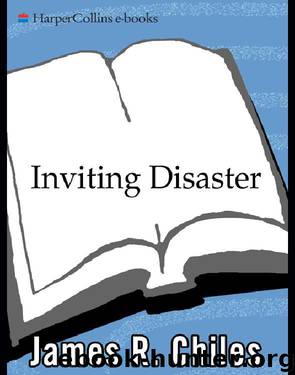Inviting Disaster by James R. Chiles

Author:James R. Chiles
Language: eng
Format: mobi, epub
ISBN: 9780061734588
Publisher: HarperCollins
Published: 2008-02-07T21:00:00+00:00
7: RED LINE RUNNING
HUMANS HAVE A LIMIT, TOO
Just hearing the words control room conjures up an image of a place that by definition is secure and calm, no matter how powerful the forces being tapped just outside. The chairs are comfortable; the operators have instruments to consult at their leisure; levers and buttons keep the machines at bay. Lights banish the shadows, and walls muffle the noise.
This appeared to be the situation shortly after midnight on April 26, 1986, when a small crowd of engineers, technicians, and foremen occupied the control room at the V. I. Lenin Chernobyl power station, Reactor 4. The reactor complex was on the edge of the Pripyat River, eighty miles north of Kiev. The crew was attempting to carry out an experiment during a short transition period as the reactor came off line and coasted to a shutdown for its annual maintenance work. The goal was to squeeze enough electrical power out of a reactor-generator set during an emergency shutdown to give time for diesel generators to come on line to pick up the power loads. But the operation wasn’t going well. When operators tried to send control rods into the reactor core, they stuck. Then the operators heard a rumbling noise followed by a pounding so deep they could feel it through the floor, like something big and scary had gotten loose out there in the quarter-mile-long turbine hall. At about the time the foreman decided the reactor was running out of water, the walls blew in and the roof fell. A white dust settled over the scene, and the lights went out.
The foreman of the reactor section ran into the room, reporting that the massive blocks on top of the reactor, almost two thousand of them, each weighing 770 pounds, were jumping up and down in a kind of maniac dance. Seconds later, another man rushed in to announce that the turbine hall was on fire. He ran back out the way he came, followed by two men from the control room. The first glance was startling enough—the roof had partially collapsed and small fires were burning—but the scariest sight had to be the red-hot rubble on the floor. Broken chunks of uranium fuel lay scattered across the yellow linoleum, along with burning pieces of graphite from the reactor.
These three men were the first to see just how out of control a wrongheaded experiment could go. Shortly, many more people would feel the heat. Two dozen reactor operators and firefighters died at the Chernobyl complex, thousands more probably died downwind, and at least seventy thousand people across northern Europe were contaminated by dangerous levels of radioactivity.
The straightforward explanation of the Chernobyl disaster is that in following orders to test the reactor’s ability to generate an emergency margin of electricity as it coasted toward shutdown, the operators turned off the automatic safety shutdown system, thus violating safety rules. These errors triggered design problems in the reactor. After running for a year and storing radioactive decay products, the reactor was going to be most unstable when operating at low power.
Download
This site does not store any files on its server. We only index and link to content provided by other sites. Please contact the content providers to delete copyright contents if any and email us, we'll remove relevant links or contents immediately.
| Automotive | Engineering |
| Transportation |
Whiskies Galore by Ian Buxton(41712)
Introduction to Aircraft Design (Cambridge Aerospace Series) by John P. Fielding(33011)
Small Unmanned Fixed-wing Aircraft Design by Andrew J. Keane Andras Sobester James P. Scanlan & András Sóbester & James P. Scanlan(32678)
Craft Beer for the Homebrewer by Michael Agnew(18076)
Turbulence by E. J. Noyes(7888)
The Complete Stick Figure Physics Tutorials by Allen Sarah(7258)
Kaplan MCAT General Chemistry Review by Kaplan(6814)
The Thirst by Nesbo Jo(6748)
Bad Blood by John Carreyrou(6468)
Modelling of Convective Heat and Mass Transfer in Rotating Flows by Igor V. Shevchuk(6349)
Learning SQL by Alan Beaulieu(6152)
Weapons of Math Destruction by Cathy O'Neil(6077)
Man-made Catastrophes and Risk Information Concealment by Dmitry Chernov & Didier Sornette(5870)
Digital Minimalism by Cal Newport;(5576)
Life 3.0: Being Human in the Age of Artificial Intelligence by Tegmark Max(5398)
iGen by Jean M. Twenge(5298)
Secrets of Antigravity Propulsion: Tesla, UFOs, and Classified Aerospace Technology by Ph.D. Paul A. Laviolette(5232)
Design of Trajectory Optimization Approach for Space Maneuver Vehicle Skip Entry Problems by Runqi Chai & Al Savvaris & Antonios Tsourdos & Senchun Chai(4949)
Electronic Devices & Circuits by Jacob Millman & Christos C. Halkias(4859)
